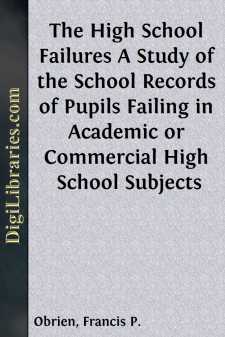Categories
- Antiques & Collectibles 13
- Architecture 36
- Art 48
- Bibles 22
- Biography & Autobiography 813
- Body, Mind & Spirit 142
- Business & Economics 28
- Children's Books 14
- Children's Fiction 11
- Computers 4
- Cooking 94
- Crafts & Hobbies 4
- Drama 346
- Education 46
- Family & Relationships 57
- Fiction 11829
- Games 19
- Gardening 17
- Health & Fitness 34
- History 1377
- House & Home 1
- Humor 147
- Juvenile Fiction 1873
- Juvenile Nonfiction 202
- Language Arts & Disciplines 88
- Law 16
- Literary Collections 686
- Literary Criticism 179
- Mathematics 13
- Medical 41
- Music 40
- Nature 179
- Non-Classifiable 1768
- Performing Arts 7
- Periodicals 1453
- Philosophy 64
- Photography 2
- Poetry 896
- Political Science 203
- Psychology 42
- Reference 154
- Religion 513
- Science 126
- Self-Help 84
- Social Science 81
- Sports & Recreation 34
- Study Aids 3
- Technology & Engineering 59
- Transportation 23
- Travel 463
- True Crime 29
The High School Failures A Study of the School Records of Pupils Failing in Academic or Commercial High School Subjects
Categories:
Description:
Excerpt
CHAPTER I
GENERAL INTRODUCTION OF THE SUBJECT
1. THE RELEVANCE OF THIS STUDY
As the measuring of the achievements of the public schools has become a distinctive feature of the more recent activities in the educational field, the failure in expected accomplishment by the school, and its proficiency in turning out a negative product, have been forced upon our attention rather emphatically. The striking growth in the number of school surveys, measuring scales, questionnaires, and standardized tests, together with many significant school experiments and readjustments, bears testimony of our evident demand for a closer diagnosis of the practices and conditions which are no longer accepted with complacency.
The American people have expressed their faith in a scheme of universal democratic education, and have committed themselves to the support of the free public high school. They have been liberal in their financing and strong in their faith regarding this enterprise, so typically American, to a degree that a secondary education may no longer be regarded as a luxury or a heritage of the rich. No longer may the field be treated as either optional or exclusive. The statutes of several of our states now expressly or impliedly extend their compulsory attendance requirements beyond the elementary years of school. Many, too, are the lines of more desirable employment for young people which demand or give preference to graduates of a high school. At the same time there has been no decline in the importance of high school graduation for entering the learned or professional pursuits. Accordingly, it seems highly probable that, with such an extended and authoritative sphere of influence, a stricter business accounting will be exacted of the public high school, as the great after-war burdens make the public less willing to depend on faith in financing so great an experiment. They will ask, ever more insistently, for facts as to the expenditures, the finished product, the internal adjustments, and the waste product of our secondary schools. Such inquiries will indeed seem justifiable.
It is estimated that the public high schools had 84 per cent of all the pupils (above 1,500,000) enrolled in the secondary schools of the United States in 1916.
The majority of these pupils are lost from school—whatever the cause—before the completion of their courses; and, again, the majority of those who do graduate have on graduation ended their school days. Consequently, it becomes more and more evident how momentous is the influence of the public high school in conditioning the life activities and opportunities of our youthful citizens who have entered its doors. Before being entitled to be considered a "big business enterprise,"it seems imperative that our "American High School" must rapidly come to utilize more of business methods of accounting and of efficiency, so as to recognize the tremendous waste product of our educational machinery.The aim of this study is to trace as carefully and completely as may be the facts relative to that major portion of our high school population, the pupils who fail in their school subjects, and to note something of the significance of these findings....


